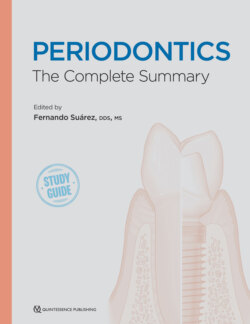Читать книгу Periodontics - Fernando Suarez - Страница 49
На сайте Литреса книга снята с продажи.
Dental Biofilm
ОглавлениеThe human oral microbiome is an exceptional habitat for many different species of bacteria. Data from molecular and culture studies with the support of the United States National Institute of Health and the Human Microbiome Project have shown that approximately 700 distinct bacterial phyla may be able to live in the oral cavity.29 Nevertheless, not all of them will be present simultaneously in a particular individual. It has been estimated that an individual subject may harbor about 100 to 200 taxa in the mouth.30 In addition, some species are site specific, while other species are subject specific.31
Oral bacteria will produce various polysaccharides and glycoproteins that have the ability to adhere to other suspended or planktonic microorganisms (coaggregation) or to other already-adhering microorganisms or surfaces (coadhesion). Additionally, salivary glycoproteins and antibodies will form the acquired pellicle on the tooth surface, which facilitates bacterial adhesion.
In 1998, Socransky et al32 were able to use the checkerboard DNA-DNA hybridization technique to identify different groups of bacteria that often exist together in subgingival plaque. Five bacterial clusters were identified and classified into different colors: red, orange, purple, yellow, and green (Fig 3-1).32 Additionally, a relationship between those bacterial clusters was identified, categorizing them in different stages and severity of periodontal disease. Actinomyces (purple complex), Streptococcus (yellow complex), and Capnocytophaga (green complex) species are considered early colonizers because these will be the first microorganisms colonizing the tooth surface. Usually the early or primary colonizers are facultative anaerobic gram-positive cocci. Later, secondary colonizers like Fusobacterium nucleatum or Prevotella intermedia (orange complex) will interact with the early colonizers, and the shift to gram-negative anaerobic bacterial flora will begin. Finally, the late colonizers, red complex bacteria such as Porphyromonas gingivalis, Treponema denticola, or Tannerella forsythia, will coaggregate with the secondary colonizers, resulting in a more pathogenic microbiota (Fig 3-2).33,34
Fig 3-1 Microbial complexes. (Adapted from Socransky et al.32)
Fig 3-2 Spatiotemporal model of oral bacteria colonizing a tooth surface. Early colonizers will attach to specific receptors on molecules of the acquired pellicle. Coadhesion of secondary colonizers, and specifically of F nucleatum, will play a role of “bridging” species from early and late colonizers because it has the ability to coaggregate with multiple bacteria. (Adapted with permission from DÜzgÜnes.34)
These bacteria associations are regulated by quorum sensing, which is the ability to detect and respond to cell density and thereby coordinate cell behavior. As such, bacteria secrete and detect autoinducer molecules, which accumulate in a cell density–dependent manner and regulate the expression of specific genes.35 A major advantage for bacteria grouped in the biofilm is the protection it provides against environmental factors such as host-defense mechanisms and toxic substances in the environment, such as antimicrobials. Along with providing protection, biofilms also facilitate the uptake of nutrients and water, as well as the removal of metabolic waste products.36 As a result, it has been estimated that organisms in biofilms could be up to 1,000 times more resistant to antibiotics as compared with their planktonic state.37
Dental calculus usually represents mineralized bacterial plaque. Supragingival calculus will be located coronal to the gingival margin and is usually whitish to dark yellow or brown, hard, with a claylike consistency and easily detachable from the tooth surface. Its rate of formation will depend on the bacterial plaque present and on the quality and quantity of the secretions of the salivary glands. Subgingival calculus is located apical to the gingival margin, so it is not visible on routine clinical examination. Occasionally, subgingival calculus may be visible in dental radiographs. Both sub- and supragingival calculus provide perfect environments for bacterial adhesion, growth, and maturation, as well as increase the surface for bacterial colonization. It is important to mention that sterilized38 or disinfected39 calculus does not trigger a marked inflammatory reaction, but the bacterial plaque attached to it will. For this, calculus is considered a secondary factor for periodontal disease, as it provides an ideal surface topography for plaque accumulation.
